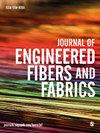3D printing applications on textiles: Measurement of air permeability for potential use in stab-proof vests
IF 2.2
4区 工程技术
Q1 MATERIALS SCIENCE, TEXTILES
引用次数: 0
Abstract
The most important piece of safety equipment is developed as a reinforced piece of body armor to resist attacks to the upper parts of the body so as to save the lives of its wearers to offer protection against stabbing with sharp-tipped objects. The majority of commercial stab resistant armors are not comfortable for users to wear during their whole duty shift. The three-dimensional (3D) printing has given great opportunity to develop equipment for a particular and individual application with the incorporation of performance and comfort. Stab protective armor has been developed by 3D printing without compromising the protection performance for a particular energy level to improve the comfort of the armor vest so that users are willing to wear during their whole duty shift. In this study, air permeability is used to measure the comfort tendency of the protective armor as a safety gear without reducing the protection performance. In this study the effect of textile materials and structures, shapes of 3D prints as the segmentation of scales, size of scales, parts of the full vest, attachments, and air exposure sides of the panel are investigated. The result revealed that the air permeability of the 3D printed protective armor vest improved the comfort as compared to the commercially available armor vests of both from a single plate and large sized segmented scales.纺织品上的 3D 打印应用:测量防刺背心的潜在用途透气性
这种最重要的安全装备是作为一种加强型防弹衣开发的,可抵御对身体上部的攻击,从而挽救穿戴者的生命,为他们提供免受尖锐物体刺伤的保护。大多数商用防刺盔甲都不适合使用者在整个值班期间穿着。三维(3D)打印技术为开发针对特定和个性化应用的设备提供了绝佳机会,同时还兼顾了性能和舒适性。通过三维打印技术开发的刺伤防护装甲,在不影响特定能量水平防护性能的情况下,提高了装甲背心的舒适度,使用户愿意在整个值班期间穿着。在这项研究中,透气性被用来测量防护盔甲作为安全装备的舒适度,而不会降低防护性能。本研究调查了纺织材料和结构、作为鳞片分割的三维打印形状、鳞片大小、整件防弹背心的部件、附件以及面板的空气暴露面的影响。研究结果表明,与市售的单板和大尺寸分段鳞片装甲背心相比,3D 打印防护装甲背心的透气性提高了舒适性。
本文章由计算机程序翻译,如有差异,请以英文原文为准。
求助全文
约1分钟内获得全文
求助全文
来源期刊

Journal of Engineered Fibers and Fabrics
工程技术-材料科学:纺织
CiteScore
5.00
自引率
6.90%
发文量
41
审稿时长
4 months
期刊介绍:
Journal of Engineered Fibers and Fabrics is a peer-reviewed, open access journal which aims to facilitate the rapid and wide dissemination of research in the engineering of textiles, clothing and fiber based structures.
 求助内容:
求助内容: 应助结果提醒方式:
应助结果提醒方式:


